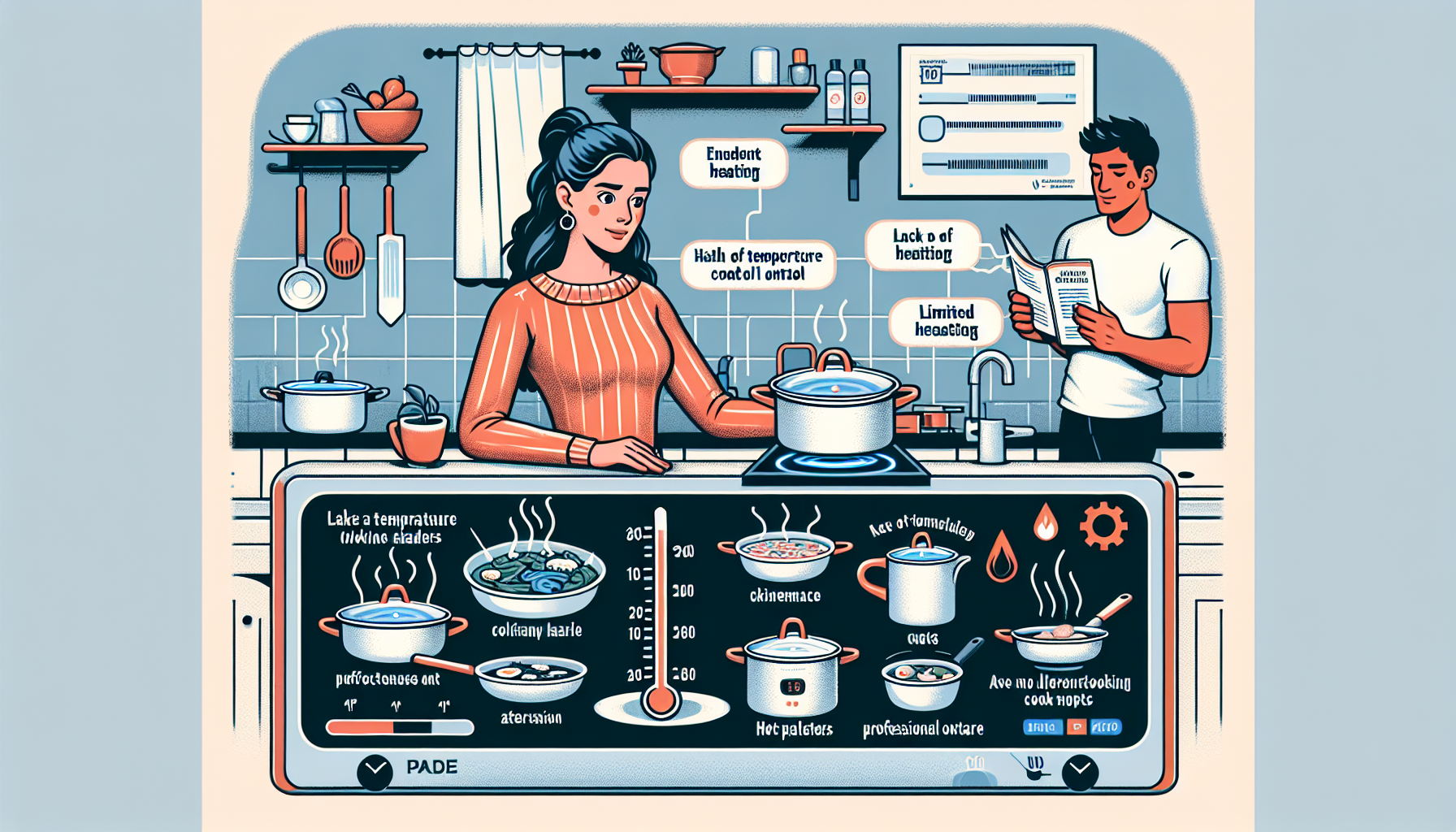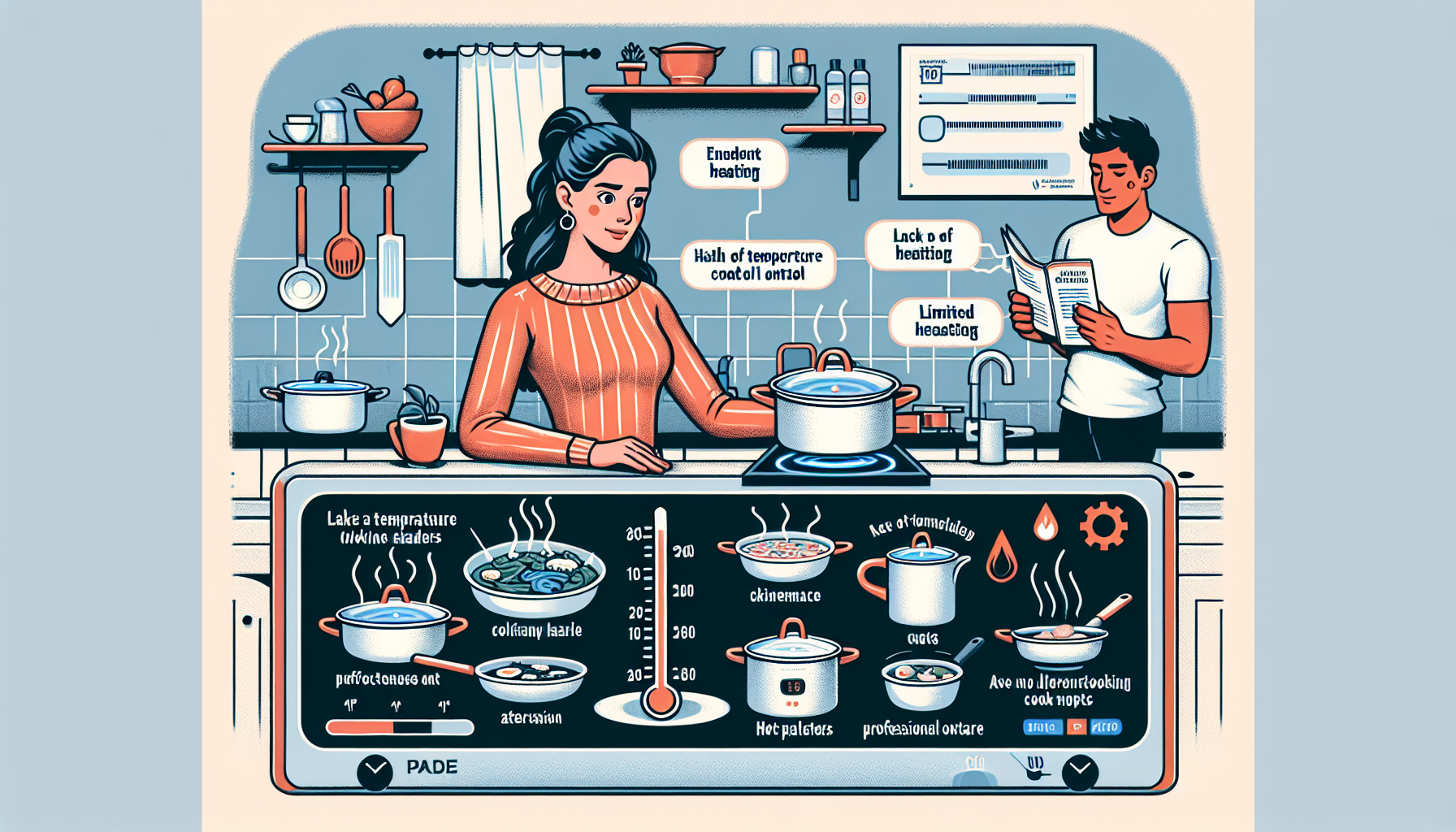Hot plates are a handy kitchen appliance that many people rely on for their cooking needs. However, behind their convenience lies a few common problems that you may encounter. From uneven heating to potential safety hazards, it’s important to be aware of these issues to ensure a smooth and worry-free cooking experience. In this article, we’ll explore the problems that often arise with hot plates and provide tips on how to overcome them. So, if you’ve ever wondered what could go wrong with hot plates, keep reading to find out!

CHECK OUT COUNTERTOP BURNERS ON AMAZON
Safety Hazards
Electrical hazards
One of the main concerns when using hot plates is the risk of electrical hazards. Hot plates rely on electricity to heat up and operate, which means that if there is any damage or malfunction in the electrical components, there is a risk of electric shocks or even fires. This can be particularly dangerous if you have young children or pets in your home who may accidentally come into contact with the hot plate.
Burn risks
Hot plates can also pose burn risks, as they can reach high temperatures and have direct contact with cookware or food. It is crucial to handle hot plates with caution and use appropriate oven mitts or heat-resistant gloves when adjusting or moving them. Additionally, the heating elements themselves can remain hot even after the hot plate is turned off, so it’s important to avoid touching them until they have cooled down completely.
Fire hazards
Another safety hazard associated with hot plates is the risk of fires. If a hot plate is left unattended or used improperly, it can easily start a fire, especially if flammable materials are nearby. It is essential to always keep a close eye on the hot plate while it is in use, ensure proper ventilation, and keep flammable items away from the hot plate to minimize the risk of fire accidents.
Limited Heat Control
Inconsistent heating
One of the common problems with hot plates is their inconsistent heating. Due to their compact design and limited heat control options, hot plates often struggle to maintain a steady temperature throughout the cooking process. This can lead to unevenly cooked food and make it challenging to achieve precise cooking results, especially when it comes to delicate dishes that require precise heat control.
Difficulty in maintaining temperature
Hot plates also pose a challenge when it comes to maintaining the desired cooking temperature. Unlike stovetops or ovens with adjustable knobs and sophisticated temperature control mechanisms, hot plates typically offer limited temperature settings, which can make it difficult to keep the heat consistent for longer cooking durations. This lack of temperature control can result in overcooking or undercooking your food, leading to less than ideal culinary outcomes.
Uneven Heat Distribution
Hot spots
Uneven heat distribution is another common problem with hot plates. Due to their small size and limited heating elements, some areas of the hot plate may become significantly hotter than others, creating hot spots. This can cause food to burn or cook unevenly, resulting in inconsistent flavors and textures. It can be especially frustrating when trying to cook delicate dishes that require precise heat distribution for optimal results.
Cold spots
On the flip side, hot plates can also have cold spots where the heat is not evenly distributed. Cooking on a hot plate with cold spots can lead to undercooked food, which can be a food safety concern, particularly when preparing meats or other ingredients that require thorough cooking. It is essential to be aware of these cold spots and adjust your cooking techniques accordingly to ensure that all parts of your dish are cooked evenly.
Limited Cooking Options
Lack of oven functionality
Hot plates usually lack oven functionality, which can limit your cooking options. While stovetops and ovens offer versatile cooking methods such as baking, roasting, and broiling, hot plates are primarily designed for basic stovetop cooking. This means that you may not be able to prepare certain dishes that require oven functions, such as baking bread or making casseroles. If you enjoy a wide variety of cooking techniques, a hot plate may not be the most suitable option for you.
Limited surface space
Another constraint of hot plates is their limited surface space. Unlike traditional stovetops that can accommodate multiple pots and pans simultaneously, hot plates usually have a smaller cooking area, which can be restrictive when cooking multiple dishes at once. This can be particularly inconvenient when you need to prepare meals for larger gatherings or cook multiple courses simultaneously. The limited surface space can also make it challenging to use larger cookware or cooking vessels that may not fit comfortably on the hot plate.
Energy Inefficiency
Wasted heat
Hot plates are generally less energy-efficient compared to other cooking appliances. As hot plates rely on electric heating elements, a significant amount of heat can be wasted during the cooking process. Unlike gas stovetops, where the heat is transmitted directly to the cookware, hot plates heat up the surrounding air, which can result in heat loss and lower overall energy efficiency. This can lead to higher electricity consumption, increasing your energy bills in the long run.
High electricity consumption
In addition to wasted heat, hot plates can consume a significant amount of electricity. The continuous use of hot plates, especially for longer cooking durations, can contribute to higher electricity consumption compared to other cooking appliances. If you are environmentally conscious or looking to reduce your energy costs, it’s worth considering alternative cooking options that offer better energy efficiency.
Poor Durability
Fragile components
Hot plates often have components that may be susceptible to damage or breakage. The heating elements, control knobs, or other parts of the hot plate may be fragile and more prone to wear and tear. Accidental drops or mishandling can easily result in damage to these components, rendering the hot plate unusable. It is important to handle hot plates with care and ensure a safe storage space when not in use to prevent any accidental damage.
Short lifespan
Due to their relatively simple design and construction, hot plates may have a shorter lifespan compared to other cooking appliances. The continuous heating, cooling, and regular use can cause wear and tear on the components, such as the heating elements or the temperature control mechanisms. While the exact lifespan of a hot plate can vary depending on the quality and usage, it’s important to consider the durability factor when making your purchasing decision.
Maintenance Challenges
Cleaning difficulty
Cleaning hot plates can be more challenging compared to other cooking appliances. There may be food spills or stains on the cooking surface or around the heating elements, which can be difficult to clean thoroughly. Depending on the specific design of the hot plate, some parts may not be easily removable for cleaning, making it harder to reach tight spots or eliminate stubborn stains. Regular cleaning is crucial to ensure the longevity and optimal performance of your hot plate.
Spills and stains
Hot plates are also more prone to spills and stains during the cooking process. The limited cooking space and the absence of raised edges or containment features can make it easier for liquids or food particles to accidentally spill over the sides. These spills and stains can not only be a hassle to clean but can also affect the overall appearance and functionality of the hot plate. It is important to be extra cautious when cooking with liquids or greasy ingredients to minimize the risks of spills and stains.
Inconvenience for Large Gatherings
Limited cooking capacity
Hot plates may not have enough cooking capacity to cater to larger gatherings or events where you need to prepare a significant amount of food. As mentioned earlier, the limited surface area of the hot plate restricts the number of pots and pans that can be used simultaneously. This can significantly slow down the cooking process and result in delays when serving meals for larger groups. If you frequently host parties or have a large family, a hot plate may not be the most practical option for your cooking needs.
Slower cooking time
In addition to limited cooking capacity, hot plates often have slower cooking times compared to stovetops or ovens. The compact size and limited heat output of hot plates can cause longer cooking durations, especially when cooking larger quantities of food. This can be inconvenient and may require you to plan and allocate more time for your cooking activities. If efficiency and quick meal preparation are important to you, a hot plate may not be the most suitable choice.
CHECK OUT COUNTERTOP BURNERS ON AMAZON
Risk of Overheating
Overheating of cookware
Hot plates can pose a risk of overheating cookware, especially if low-quality or incompatible pots and pans are used. The direct contact with the heating elements can cause certain cookware materials to get extremely hot, potentially damaging the cookware or affecting its performance. It is important to use cookware that is suitable for use on hot plates and can handle the high temperatures. Avoid using cookware with plastic or wooden handles, as they can melt or catch fire when exposed to excessive heat.
Risk of food burn
Another risk associated with hot plates is the potential for food burn. The high temperatures that hot plates can reach, combined with their limited heat control, can easily lead to food burning if proper attention is not given. It is crucial to monitor your cooking closely and adjust the heat settings as necessary to prevent food from burning, which can ruin the taste and texture of your dishes. Being mindful of the cooking time and heat distribution can help minimize the risk of food burn on hot plates.
Lack of Safety Features
No automatic shut-off
Unlike some other cooking appliances, hot plates often lack automatic shut-off features. If left unattended or accidentally turned on for an extended period, hot plates will continue to heat up until manually turned off. This can be a safety concern, especially if you forget to turn off the hot plate after cooking. It is essential to be cautious and responsible when using hot plates, ensuring that you always turn them off and unplug them when not in use.
No child-lock mechanism
Hot plates do not typically come with child-lock mechanisms, which can pose a risk if there are children in the household. The exposed heating elements and the hot surface of the hot plate can be tempting for curious children, increasing the risk of burns or accidents. It is important to take extra precautions around hot plates when children are present, such as using safety gates or keeping them out of reach to prevent any mishaps.
In conclusion, while hot plates offer convenience and portability for cooking in spaces without traditional stovetops or ovens, they come with their fair share of problems. Safety hazards, limited heat control, uneven heat distribution, limited cooking options, energy inefficiency, poor durability, maintenance challenges, inconvenience for large gatherings, risk of overheating, and a lack of safety features are all noteworthy concerns. Understanding these problems can help you make an informed decision when considering whether a hot plate is the right cooking appliance for your needs.
